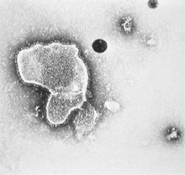NIAID Lab Developing Intranasal RSV Vaccines
Respiratory syncytial virus (RSV) is the most common cause of serious lower respiratory tract infections in infants and young children worldwide: In the United States alone, nearly all children become infected with RSV by age 2, with 75,000 to 125,000 of them hospitalized each year. Globally, RSV affects an estimated 64 million people and causes 160,000 deaths each year.
While all children are at risk of RSV disease, the incidence of severe disease is highest in children with cardiopulmonary disease and in those born prematurely; these high-risk children account for nearly half of RSV-related hospital admissions in the United States. Another at-risk population is the elderly, who often suffer from flu-like symptoms caused by RSV.
 |
An electron micrograph of respiratory syncytial virus (RSV). RSV is the most common cause of bronchiolitis and pneumonia in children less than 1 year of age.
Credit: CDC/E. L. Palmer |
Currently, no RSV vaccine is available, but in NIAID’s Laboratory of Infectious Diseases (LID), co-chief Brian Murphy, M.D., and senior investigator Peter Collins, Ph.D., are developing two vaccine candidates that may eventually provide much-needed protection against this highly contagious disease.
Eliminating the Needle
Current preventive methods for RSV are limited and costly. There is a single preventive medicine on the market, called palivizumab (marketed under the brand name Synagis), which was created using a monoclonal antibody developed at LID.
Synagis is typically given to high-risk infants and young children during the RSV season. The protection it offers fades relatively quickly as the antibodies degrade and are removed from the body’s circulatory system. Therefore, the treatment must be given once a month by injection into the thigh muscle. Finding a vaccine that provides long-term immunity and is safe for infants would greatly ease this burden.
LID’s candidate vaccines are designed as nasal sprays, like the FluMist influenza vaccine. Delivering an RSV vaccine intranasally, as opposed to using a needle, makes it easier to administer, especially for infants and young children. The nasal spray also provides direct stimulation of local immunity in the respiratory tract (nose, sinuses, throat, and lungs) as well as systemic immunity (the response of disease-fighting immune cells).
How the Vaccines Are Made
LID’s candidates are live, attenuated vaccines. This means that they are based on a version of the virus that has been weakened in the lab so it can’t cause disease. By mimicking natural infection, live, attenuated RSV vaccines could induce a broad, potent immune response against the disease.
LID researchers used a technique called reverse genetics to develop different methods of weakening, or attenuating, RSV. Breaking down the virus into individual proteins and genes, Dr. Collins and other LID scientists were able to identify several proteins that could be removed to leave a weakened but viable virus, as well as other kinds of mutations that attenuated the virus. The results provided them with several options from which to choose the most promising attenuated versions of the virus.
LID researchers have also used reverse genetics to create a combined vaccine against RSV and parainfluenza virus (PIV)-3, which is another major cause of respiratory infection in young children. Specifically, they modified a live, attenuated PIV-3 vaccine virus that already was under development, creating a single virus that can act as a vaccine against RSV and PIV-3. Because children are exposed to both RSV and PIV, administering this bivalent (or two-part) vaccine will not artificially expose them to any new viruses. The bivalent vaccine would have the advantage of protecting against disease caused by two major pediatric viruses.
Next Steps
NIAID, with Dr. Collins as lead scientist, currently has a Cooperative Research and Development Agreement with MedImmune to develop and evaluate live, attenuated vaccines against RSV, PIV-3, and several other related respiratory viruses.
Evaluation of the leading live, attenuated RSV vaccine candidate will enter Phase II clinical trials in 2009. The next three to five years will provide crucial information on the effectiveness of the vaccine in preventing serious RSV disease, as well as clinical evaluation for some of the most promising candidates. The primary goal is to develop an RSV vaccine that is both strong enough to stimulate the immune system and safe enough that infants are at no risk from the vaccine itself.
back to top